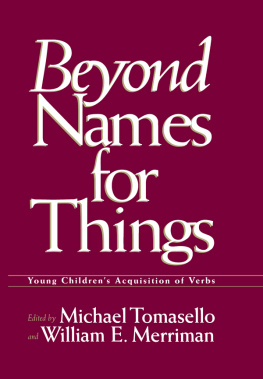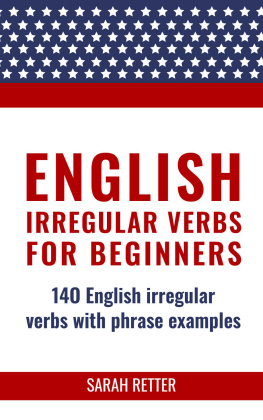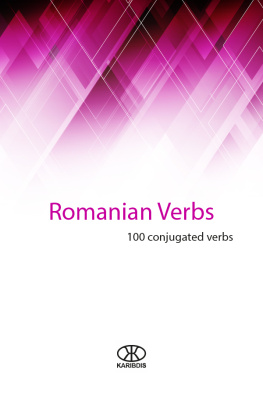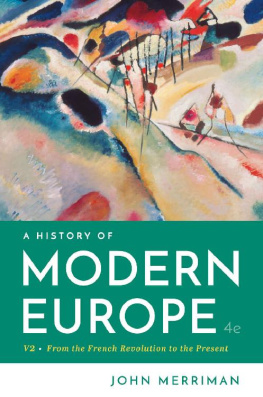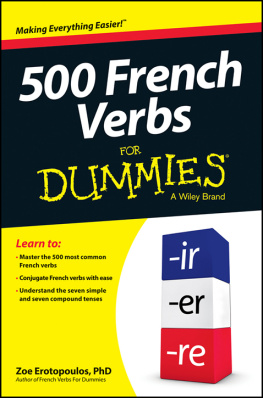BEYOND NAMES FOR THINGS
Young Childrens Acquisition of Verbs
BEYOND NAMES FOR THINGS
Young Childrens Acquisition of Verbs
edited by
Michael Tomasello
Emory University
William E. Merriman
Kent State University
First published 1995 by Lawrence Erlbaum Associates, Inc.
Published 2014 by Psychology Press
711 Third Avenue, New York, NY, 10017
and by Psychology Press
27 Church Road, Hove, East Sussex, BN3 2FA
Psychology Press is an imprint of the Taylor & Francis Group, an informa business
Copyright 1995, by Lawrence Erlbaum Associates, Inc.
All rights reserved. No part of this book may be reprinted or reproduced or utilised in any form or by any electronic, mechanical, or other means, now known or hereafter invented, including photocopying and recording, or in any information storage or retrieval system, without permission in writing from the publishers.
Trademark notice: Product or corporate names may be trademarks or registered trademarks, and are used only for identification and explanation without intent to infringe.
Cover design by Jan Melchior
Library of Congress Cataloging-in-Publication Data
Beyond names for things: young childrens acquisition of verbs /
edited by Michael Tomasello, William E. Merriman.
p. cm.
Includes bibliographical references and index.
ISBN 0-8058-1250-4 (alk. paper)
ISBN 978-0-805-81250-3 (hbk)
1. Language acquisition. 2. Grammar, Comparative and general
Verb. 3. Grammar, Comparative and generalSyntax. I. Tomasello,
Michael. II. Merriman, William Edward.
P118.B49 1995
401.93dc20 94-21937
CIP
Publishers Note
The publisher has gone to great lengths to ensure the quality of this reprint but points out that some imperfections in the original may be apparent.
Contents
William E. Merriman and Michael Tomasello
Patricia Smiley and Janellen Huttenlocher
Alison Gopnik and Soonja Choi
Susan R. Braunwald
Michael Tomasello
William E. Merriman, John Marazita, and Lorna Jarvis
Roberta Michnick Golinkoff, Kathy Hirsh-Pasek, Carolyn B. Mervis, William B. Frawley, and Maria Parillo
Katherine Nelson
Douglas A. Behrend
Anne Lederer, Henry Gleitman, and Lila Gleitman
Letitia G. Naigles, Anne Fowler, and Atessa Helm
Matthew Rispoli
Martin D. S. Braine and Patricia J. Brooks
Michael Maratsos and Gedeon Dek
William E. Merriman
Kent State University
Michael Tomasello
Emory University
In the closing 200 pages or so of their encyclopedic work, Language and Perception, Miller and Johnson-Laird (1976) offered a thorough account of adult verb semantics and identified numerous gaps in our knowledge of how the meanings of verbs change during childhood. Few lexical developmentalists heeded the call for research, however. Most chose to study other kinds of terms instead, most notably object labels. It is actually only within the last 5 years that the empirical literature on verb meaning acquisition has grown to the point where an edited volume on the topic has become a realistic possibility.
We do three things in this introduction: identify some causes of the fields near obsession with object labels, consider why investigators have recently begun to turn their attention to verbs, and finally, present a synopsis of each chapter in the book.
DOMINANCE OF THE OBJECT LABEL
Although some studies of the semantics of childrens verbs were published in the 1970s and early 1980s, and the research programs of a few persons such as Eve Clark, Janellen Huttenlocher, and Dedre Gentner included this lexical domain, much more attention was paid to childrens acquisition of object labels. Several factors promoted this overriding interest in names for things. These words were judged to be particularly well suited for (a) pitting Clarks and Nelsons early theories against each other, (b) examining the development of natural categories, (c) investigating early developing capacities for class logic, (d) exploring the relation between word meanings and nonlinguistic concepts, and (e) studying word learning without needing to know much about linguistic theory, much less having to choose between rival accounts. Finally, the belief that object name learning is the simplest kind of lexical acquisition undoubtedly played a role.
Clarks and Nelsons Theories
Semantic feature theory (Clark, 1973) and functional core theory (Nelson, 1974) dominated the field of early lexical development in the 1970s. The central predictions of the former were that youngsters terms would be overgeneralized and interpreted as synonymous with related terms until differentiating features were acquired. Although the theory covered all types of words, the empirical projects that addressed it primarily concerned object labels and relational terms other than verbs (e.g., quantitative, spatial, and temporal words).
One impetus for the research on object labels was the conflict between Clarks (1973) proposals and Nelsons (1974) theory, which was exclusively concerned with names for things. From an analysis of overextensions, Clark concluded that early noun intensions consisted of one or two static perceptual attributes, most frequently shape. In contrast, Nelson contended that children did not give as much weight to such features as they did to object function. The question of the relative importance of shape, function, and other attributes in young childrens generalization of novel object words has guided many investigations ever since (see Merriman, Scott, & Marazita, 1993, for a recent example). A current recasting of the question is whether youngsters assume by default that a novel word will be extendable to all similarly shaped objects. This operating principle has been given a variety of namesShape (Landau, Smith, & Jones, 1988); Object Kind (Hall, Waxman, & Hurwitz, 1993); Categorical Scope (Golinkoff, Hirsh-Pasek, Mervis, Frawley, & Parillo, this volume).
The two theories also clashed regarding the prevalence of object name overextensions. Nelson (1974) noted instances of both conventional mapping and underextension, and Anglin (1977) followed with further evidence of the latter as well as methodological arguments for why analyses of childrens production might overestimate the frequency of overextension. Numerous studies of the nature of naming errors have since filled the pages of books and journals. Nearly all have focused on object labels, even though most of young childrens adjectives and verbs have extensions and so could be assessed with respect to this issue.
Natural Categories
The emphasis on object names was also maintained by the ecological turn taken in the scientific study of categorization in the 1970s. Labov (1973) showed how the boundaries of common object name extensions were not fixed but could be altered by perceived functional context (e.g., something that looked more like a cup than a bowl would be called bowl if it was being used to hold cereal). This result challenged the classical analysis of word intensions as immutable sets of individually necessary and jointly sufficient features. The death blow to this analysis was delivered by Rosch and Mervis (Mervis & Rosch, 1981; Rosch, Mervis, Gray, Johnson, & Boyes-Braem, 1976), who demonstrated in a host of processing tasks the nonequivalence of the various members of a natural object category and of the various object categories in a natural class inclusion hierarchy. Some members/categories were judged to be better than others; these prototypical members/basic level categories were verified fastest and served as the reference points to which other members/categories were compared. Rosch (1975) also provided evidence for the special status of focal colors, ideal geometric forms, round numbers, and landmark spatial directions, but she did not address actions and their descriptions.
Next page
